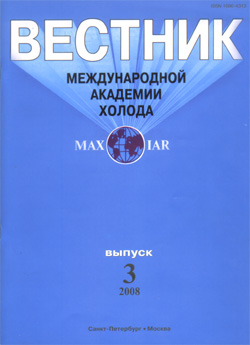
Frictional pressure drop in a boiling refrigerant flow in pipes

Annotation
Two methods are used in this country to calculate pressure drops in a boiling two-phase flow through smooth pipes. The transition to new refrigerants and the increase of their mass flow rate in evaporators call for the need to improve the accuracy of calculating frictional pressure drop during evaporation of different refrigerants. Based on the analysis of foreign sources, four generalized correlations were selected. They take into account the properties of the boiling liquid and are based on specific experimental data sets. For the sake of comparison, calculations of pressure drops were made using the homogeneous model and four models of separate phase movement at different combinations of refrigerant boiling conditions. The calculation results show that sufficient accuracy and relative simplicity is provided by the Müller-Steinhagen and Heck correlation. The model which takes into account the change of flow regimes during the movement of boiling liquid seems promising but too complicated. The most credible is the result of pressure drop calculations for given conditions when it appears roughly similar for two or three methods.
Keywords
Постоянный URL
Articles in current issue
- Simulation and a mathematical program for calculating the value of effective radiation
- The refrigerant’s future: The phase down of HFCs and its consequences
- A technique for optimization of the parameters of the cryostatted screen in a cryovacuum test bench
- Modified ozone-friendly refrigerant mixtures as substitutes for R22
- Mathematical model for the cleaning of fat-containing wastewater by ozonation at refrigerating enterprises
- A pilot study of aero- and thermodynamic processes in the apertures equipped with heated air curtains
- Results of monitoring temperature fields in the basement of the Triumph Stadium in Yakutsk
- Manufacturing dried and salt-cured fish products with various flavours from perch with the use of sauces
- Generalized correlations of the isobaric heat capacity on the saturated liquid line for freon mixtures
- Heat exchange calculation for the process of air movement in surface air coolers
- Radiating thermoelectric device with power recuperation
- Possibilities of employing cryogenic optoelectronic systems for detection of asteroids
- The problem of the accuracy of temperature measuring by means of a thermographic camera
- Optimization of operation modes in a refrigerating unit with the accumulator of natural cold using the method of thermoeconomic analysis
- Features and efficiency of applying heat pump units for heating buildings at railway hump yards
- Frictional pressure drop in a boiling refrigerant flow in pipes
- Analysing overall performance of a reciprocating expander at variable durations of admission process
